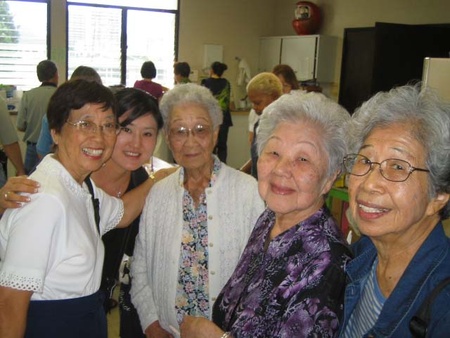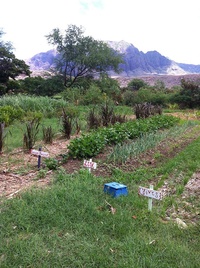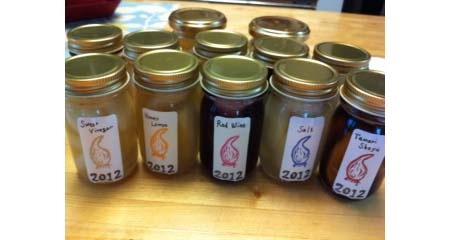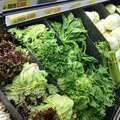1) The Homemade flavor of grandma’s tsukemono

Tsukemono sold in a Hawaiian supermarket. Several types of tsukemono are available in store. Recently, private brands have been spotted more often. (Pictured: Maui Takuan by M. Uradomo Farms, Inc.)
Currently, a wide variety of Japanese food items can be found at Japanese super markets in America. Amongst them are tsukemono (Japanese pickled vegetables) which can be found in multiple styles, from asazuke (lightly pickled vegetables) to nukazuke (vegetables pickled in brine and fermented rice bran), using various vegetables such as ginger, cucumber, Chinese cabbage, and Japanese leeks.
In addition to the goods exported from Japan, nowadays we are starting to see local Japanese food manufacturers producing tsukemono and selling them under a private brand. The flavor of the tsukemono, although slightly customized to appeal more to locals, is comparable to its Japanese counterpart.
These tsukemono are sold in American supermarkets, just as they are in grocery stores in Japan. However, for someone like me who grew up in the countryside of Kyushu (southern Japan), there is a strong tendency to identify “Tsukemono” as something that is “Homemade”.
Part of the reason for that is because I grew up eating my grandma’s homemade rakkyo (sour-sweet pickle of Japanese leek) and umeboshi (pickled dried plums) at my grandparents’ farmhouse. Every year, as soon as the vegetables in season were harvested, my grandma would make the tsukemono and it would show up on the table for our meals for the rest of the year. That was business as usual during my upbringing in the countryside.

Photo of my grandparents holding my infant mother on their countryside farm in Kyushu, Japan. Several types of tsukemono were made in many countryside households back then.
2) Connecting to my family’s roots through the Japanese dietary culture
After graduating college, I lived in Honolulu for three years to attend graduate school. I happened to have an uncle from my grandma’s side of the family living in Honolulu. Although we had kept in touch with his family, it was actually the first time meeting my Nikkei relatives. After crossing the ocean, I discovered two things: how the Nikkei community connected to our family roots, and how “TSUKEMONO”—a staple in Japanese dietary culture—had ingrained itself in the local dietary culture.
Grandma Susie and Grandpa George were Nikkei American Nisei—of the same generation as my grandparents—and their dietary habits were quite similar to that of my grandparents in Japan. Susie was a great cook and she would make her own takuan (pickled daikon radish) and pickled ginger, so while I was far away from Japan in Honolulu, there was still tsukemono on the dinner table. Apparently, the recipe for the tsukemono had been passed down to Susie from her Nikkei Issei mother. Also, back when I was young, my grandmother had been sending rakkyo, umeboshi, and other Japanese food items to Honolulu, and along with her letters she had sent the recipes to her homemade tsukemono. Ever since then, this Japanese dietary staple of “tsukemono” had bridged the ocean to preserve our family roots.
Susie took these recipes and made her own homemade tsukemono, and even sent them to her relatives in mainland USA as well as other Nikkei relatives. I felt that the Japanese cultural attitude towards preserving family ties still resonated strongly in the Nikkei community abroad.

With members of the Moiliili Hongwanji Buddhist Women’s Association. These Nikkei Hawaiian ladies are always a joy to be around. They always greet me with warm regards in my bi-annual visit to the temple.
3) Spreading TSUKEMONO culture to the world
In graduate school, I studied community development for the Nikkei community in Honolulu. This gave me an opportunity to interact often with members of the Buddhist Women’s Association of the Jodo Shinshu Hawaii Hongwanji Temple, which was one of my subjects in my dissertation.

Organic tropical fruits and vegetables harvested from Kahumana Organic Farm in Hawaii. Using local produce in conjunction with Japanese spices and my grandma’s recipe, I am hoping to produce and commercialize a unique original brand of tsukemono.
I went back to Japan once a year, and every time the local Nikkei women would eagerly wait for me to return with the rakkyo and umeboshi that I asked my grandma to make for me. They all happily accepted the tsukemono that I shared with them upon my return, saying “We’ll eat it with great care!” The homemade flavor of my grandma’s tsukemono was hugely popular with the Nikkei women, as it seemed to conjure up memories of food made by their own mothers and grandmothers. I began to wonder if I can duplicate my grandma’s homemade, country-style rakkyo and umeboshi flavor in America.
However, Japanese leeks and plums can only be harvested once a year, and they are difficult to grow in Hawaii. Therefore, most of the produce would need to be imported from mainland USA or Japan.
That is why I’m currently working on starting a business of making original tsukemono using locally harvested organic vegetables and fruits. Distinctly Japanese ingredients such as rice vinegar, soy sauce, and miso will be used, combined with the secret recipe passed on from my grandma. The goal here is not to replicate my grandma’s orthodox Japanese food completely, but rather to use what I learned from my experiences in America and interactions with the Nikkei community, and take on a style that emphasizes the importance of “maintaining our family roots through Japanese dietary culture, and passing it on to the next generation.”
I want to tell Japanese/Nikkei people all around the world about what I gathered from my experience living with Grandma Susie and Grandpa George in Honolulu: even in a faraway place overseas, the Japanese food culture has a strong lineage, and it continues to play a vital role in keeping family ties and roots bound together.

Rakkyo products, currently under development. These rakkyo are the first in the series of Grandma’s Pickles Story products. The plan is to make several different types of tsukemono in the future. In addition to the standard sweet vinegar flavor, others such as salt, honey-lemon, red wine, tamari shoyu (rich soy sauce), and kimchee flavors are in the works, aiming to appeal to the younger Sansei and Yonsei generations. My dream is to share my mother’s rakkyo with the Nikkei community around the globe.
* * * * *
Our Editorial Committee Selected this article as one of their favorite Itadakimasu! stories. Here are the comments.
Comment from Yukikazu Nagashima:
There were several skilled writers and I enjoyed reading each of the essays, but staying in tune with this particular theme, I selected this piece by Asami Goto.
There are 3 stories here: First, a story of how tsukemono played a role in connecting her family’s Japanese roots to her uncle’s family in Honolulu; Second, a story of how her grandmother’s homemade tsukemono created a psychological connection for the members of the Buddhist Women’s Association, as they recalled their own mothers’ home-cooked flavor; and Third, that the aforementioned “discoveries” had developed the author’s own desire to start up a tsukemono-based business. These stories come together succinctly, and through it the author’s enthusiasm toward her new business can be felt. It sure made me hope that her business will be a success.
Yasuko Nakamachi’s essay was also a delightful, noting the role of her chop suey restaurant and the different ways in which the customers enjoyed the fortune cookies.
Comment from Hirochika Nakamaki:
Instead of the traditional American dill pickles, the flavor of choice that this author discovered from her Nisei relatives in Honolulu was the takuan and pickled ginger made by a Nisei Grandma. Japanese tsukemono such as rakkyo and umeboshi seem to be loved amongst the members of the Buddhist Church in Honolulu.
It’s just tsukemono—yet that simplicity makes it all the more great. Dietary traditions tend to be inherited by families and organizations, but I was especially intrigued by the author’s idea to pass these flavors onto the next generation through her new business. That a particular palate can affect not only a cultural identity, but also influence international business, is a unique characterization of the modern ‘globalized’ state of the world.
Also held in high regard was the essay by Naomi Kimura about Brazilian okaki and Hanaume’s umeboshi, as well as the short story by Yasuko Nakamachi, taking an unconventional look at the fortune cookie.
© 2012 Asami Goto




